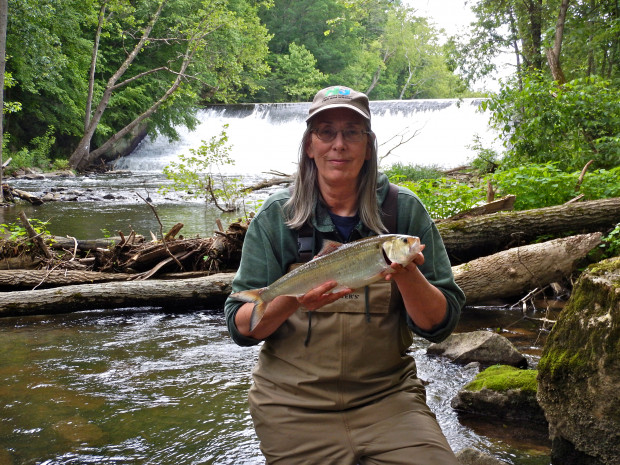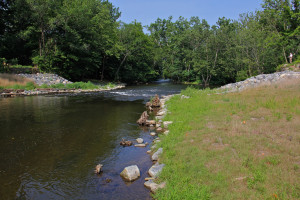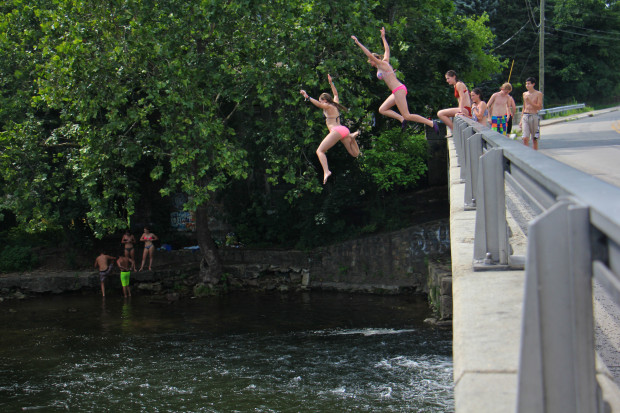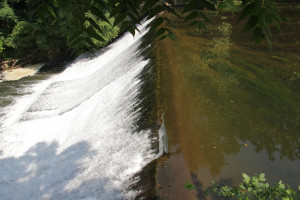Dam removal helps American shad return after disappearing for centuries
-
Catalina Jaramillo/WHYY

Courtesy of New Jersey Fish and Wildlife
Biologist Pat Hamilton holds a shad caught near the Warren Glen Dam on the Musconetcong River in Holland Township.The American shad is making an impressive come back to the Delaware River watershed.
For the first time in centuries, the American shad entered the Musconetcong River during its spring spawning migration upriver this year. The Musky, as it’s known to locals, is a tributary of the Delaware in Northwestern New Jersey. The Hughesville Dam, standing 18 feet tall and 150 feet wide, had blocked its way.
But with the dam demolished last September, the American shad, the largest of the herring family and an angler’s favorite, swam up the Musconetcong for the first time since colonial times.
“It tells quite a story that as soon as you remove a dam — at least on this river — the shad, the next opportunity, are right there,” said New Jersey Division of Fish and Wildlife’s principal biologist Pat Hamilton.
Hamilton first heard of the shad in the Musky in early June from anglers fishing trout near the former Hughesville Dam spot. She and her team almost couldn’t believe it, so they rushed to the site with fishing gear and cameras. In about an hour, she had one in hand.
“It was thrilling,” Hamilton said. “One of the high points of my career I would say.”

Emma Lee/WHYY
Piles of rock mark the spot where the Hughesville Dam once stood on the Musconetcong River.
The Hughesville dam was the last of five dams removed from the Musconetcong since 2008 by a river restoration program led by the Musconetcong Watershed Association, in partnership with federal, state, non-profit and private entities. The Gruedyke Mill Dam was removed in 2008. That was followed by the Seber Dam in 2009, the Riegelsville and Finesville Dams in 2011 and the Hughesville Dam in 2016. The project has opened the last six miles of a 46-mile long river that rises out of Lake Hopatcong, between Sussex and Morris counties.
“It [the return of the shad] is a very visible evidence that at least one of the goals of removing the dams have been accomplished, which was to restore the pathways for them to go back to their historic spawning grounds,” Hamilton said.
The American shad is a large type of herring that can weigh from four to eight pounds. They’re a prized game fish for anglers because they’re strong and they fight back, and shad roe — the fish eggs — are considered a delicacy.
Shad population decreased drastically during the last century as pollution, overfishing, and dams built to generate power diminished their habitat. Dam removal and pollution control programs in the Delaware River have brought their numbers back. But New Jersey still has nearly 1,700 regulated dams over five feet tall, and an unknown number of smaller, unregulated dams.
The first dams were built by European settlers to power mills, and later by larger industries and developers, to create lakes for vacationers and home buyers.
According to the Musconetcong Watershed Association’s Alan Hunt, some of the first dams in the Musconetcong were built in the early 1700s. “So perhaps, it might have been the first time a fish like the shad has been in that section of the river for 300 years,” Hunt said.

(Emma Lee/WHYY)
Teenagers take turns jumping into the Musconetcong river just below the Asbury Mill Dam.
Although most dams are obsolete, expensive to maintain and dangerous, dam removal is not always popular. Some locals don’t want to lose their favorite swimming holes. But Hamilton says dams create unhealthy rivers. The artificial barriers stop the natural flow, making sediments accumulate and the water warmer.
“Environmentally, they alter the ecosystem, but they’re also a hazard for humans,” Hamilton said.
Hunt said removing dams is also good for tourism because it transforms still and warm ponds into free-flowing, fast-moving currents, good for kayaking and fishing.
“We don’t have the need anymore for those structures. But we do have a need for recreation,” Hunt said.
And although it’s illegal to take Shad from any New Jersey freshwater area except the Delaware River, Hunt said this might mean that other fish like trout will return to the Musky.
“There’s economic development that gets generated when people come out from other places and they come fishing here, they spend a night, they visit our local restaurants,” Hunt said.
There’s still about 20 dams in the Musconetcong, but plans are not in place to remove all of them, only those that no longer serve a purpose. The next one in line is the Warren Glenn Dam, located about a mile north of the former Hughesville Dam site. It’s the largest of the dams to be removed so far. It stands more than 30 feet high and 150 feet wide, and it’s located in a gorge.

(Emma Lee/WHYY) / (Emma Lee/WHYY)
The 30-foot-high Warren Glen Dam is the largest dam on the Musconetcong River.
Hunt estimates removing the Warren Glen Dam will cost about $8 million — the Hughesville cost about $2 million — and it will require a feasibility study to see how much sediment that has accumulated over the years, needs to be removed.
“If everything is going great — the sediment is clean, the funding keeps pace with it — it could be within three years,” Hunt said. “We’re excited to do it, and we think our partners are fired up to do it too, based on the success with this dam and seeing how quickly the migratory fish has returned.”
Removing Warren Glen would open another five miles of free-flowing river for migratory fish like the shad and uncover the rocky walls of the gorge.
“It would be amazing,” Hamilton said. “It will be an amazing transformation.”
And because shad spend three to six years in the ocean and then return to freshwater in the spring to spawn, the removal might happen right on time for those born in the Musky this summer to come back.
After the Warren Glen Dam, there are plans to remove dams in the towns of Bloomsbury and Asbury. The restoration of the Musconetcong watershed also improves the water quality downstream. Dam removal creates a stronger fresh water flow that pushes the salt line down, which will protect drinking water intakes for cities like Philadelphia from future sea level rise.
















